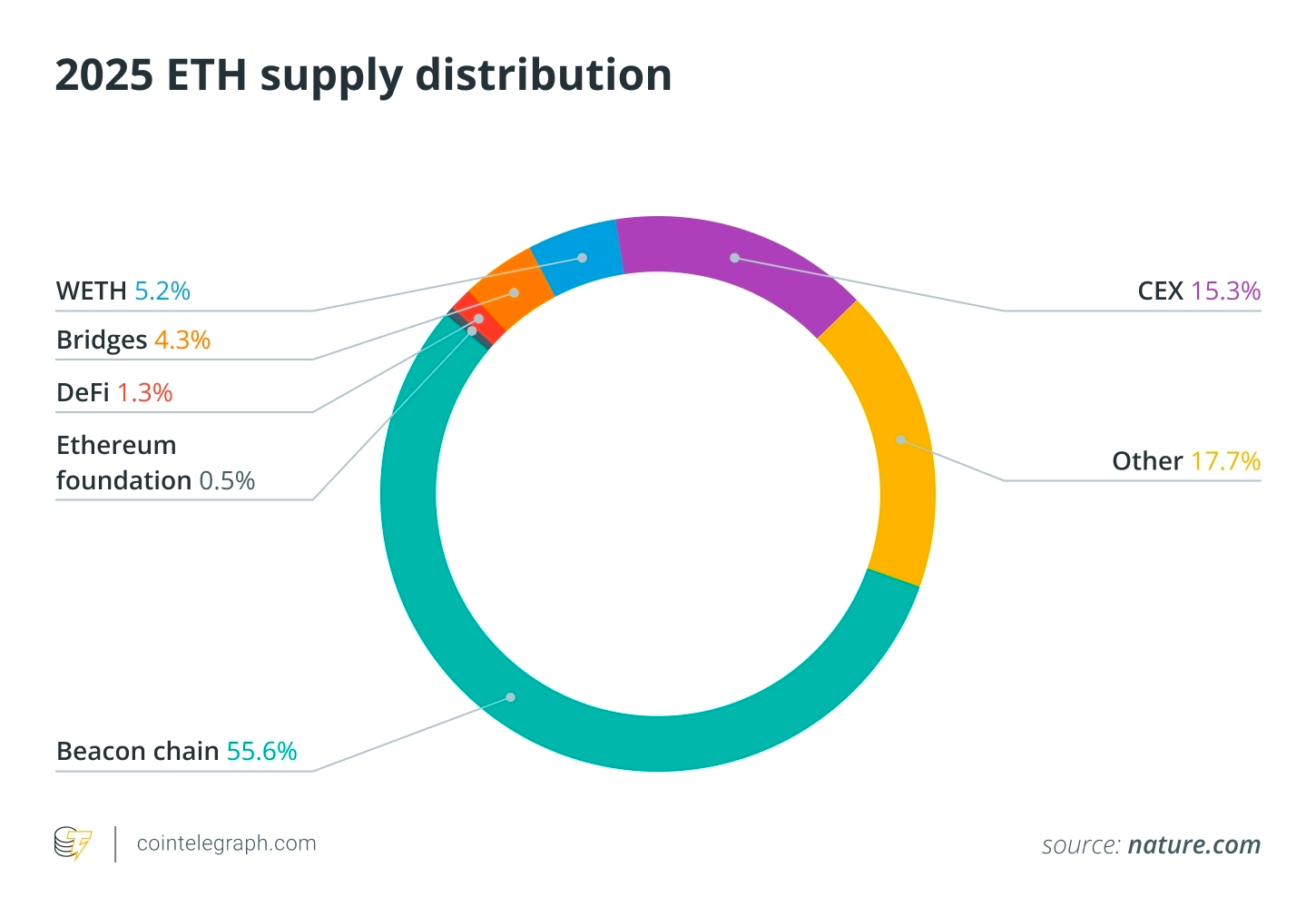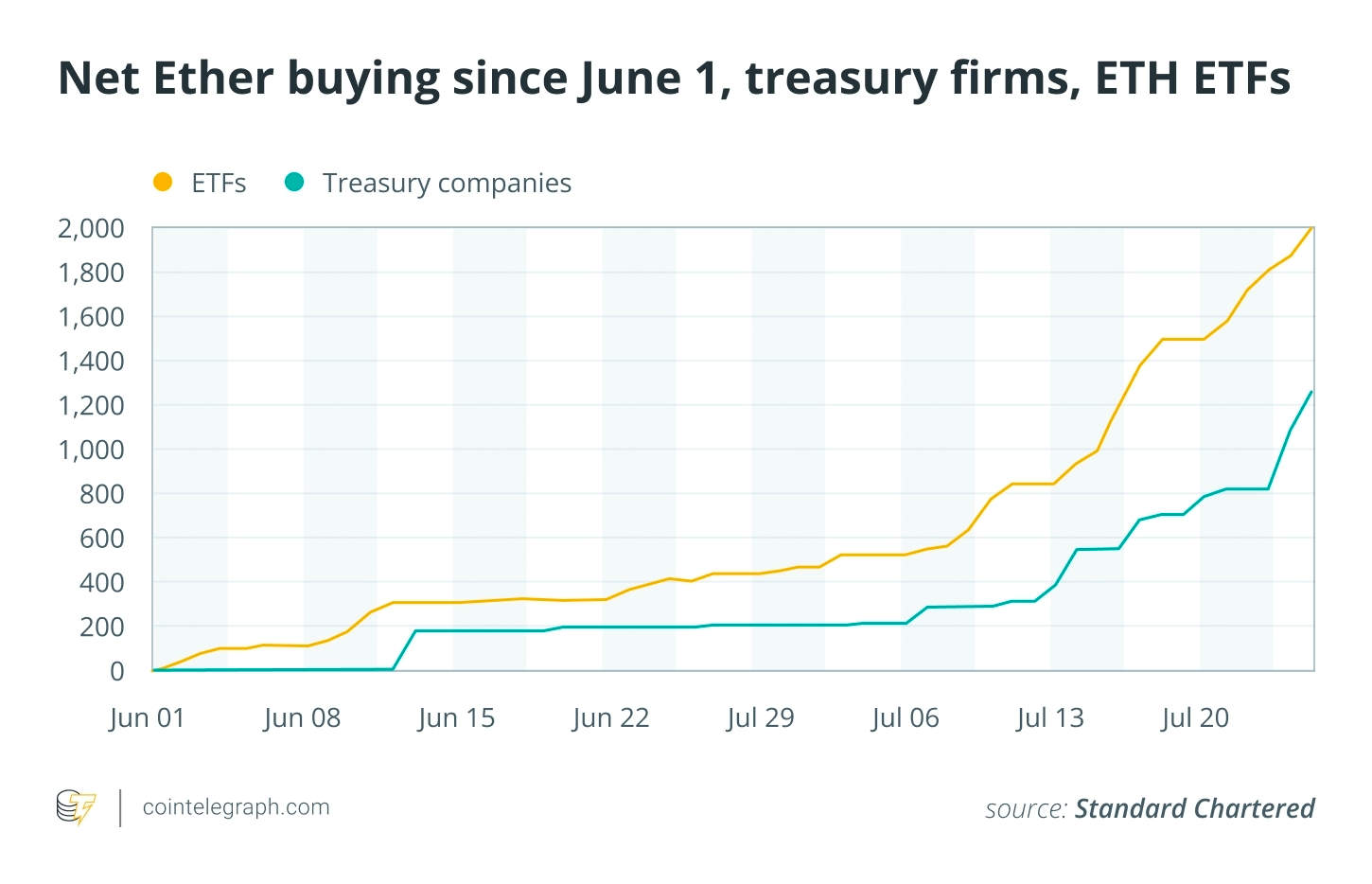Written by: Cointelegraph
Translated by: White55, Mars Finance
Key Points:
- About 70% of ETH is held by 10 addresses, but most belong to staking contracts, exchanges, or funds, rather than individual whales.
- Nearly half of the ETH is located in a smart contract: the Beacon deposit contract that supports Ethereum's proof-of-stake system.
- Large institutions and publicly traded companies like BlackRock and Fidelity currently hold millions of ETH, making ETH an important financial asset.
- The ownership of ETH has shifted from early adopters. Today, everything revolves around the platforms and services built on it.
As of September 2025, on-chain data shows that the top 10 Ether holders control about 83.9 million ETH (approximately 70% of the total circulating supply).
As a result, the community has begun to ask: who really holds most of the ETH? The answer points to protocol-level smart contracts, major exchanges, exchange-traded fund (ETF) trusts, and even publicly traded companies.
This article explores the Ethereum millionaire list of 2025, from the Beacon staking contract and Coinbase's hot wallet to BlackRock's ETHA trust and Vitalik Buterin's legendary holdings.
Top Ether Addresses by Balance
As of mid-2025, the circulating supply of Ether is approximately 120.71 million ETH.
Since the Pectra upgrade in May, the issuance has stabilized at nearly zero levels. This provides context for understanding the distribution of Ether ownership.
A brief overview shows that as of August 4, 2025, the top 10 Ether addresses hold 83.9 million ETH (about 70% of the total supply).
Looking at a broader scope, the top 200 wallets account for over 52%, holding more than 62.76 million ETH (most of which is related to staking contracts, exchange liquidity, token bridging, or custodial funds). Unlike inactive Bitcoin whale addresses, these Ethereum whale addresses are actively used infrastructure, reflecting ETH's capacity to support staking, decentralized finance (DeFi), and institutional operations.
Who Owns the Most Ether in 2025?
As of August 4, 2025, the Beacon deposit contract holds approximately 65.88 million ETH, accounting for about 54.58% of the total circulating supply of 120.71 million ETH.
This data is roughly consistent with a report from March 2025, which estimated the share to be around 55.6% (see the chart below).

This smart contract serves as the entry point for Ethereum validators, each of whom must deposit at least 32 ETH to participate in securing the network.
Even after the withdrawal feature was enabled in 2023, funds cannot flow immediately. Validators must exit the active set, wait for an unbonding period of about 27 hours, and then rely on protocol-controlled sweeps to release ETH.
This makes the Beacon contract the largest holder of ETH—not individuals, but the network itself.
By significantly reducing penalties and structuring exit mechanisms, it ensures validators' accountability. However, some critics argue that concentrating half the supply in one contract poses systemic risks in the event of a coordinated exit or vulnerabilities at the protocol layer.
Did you know? The Wrapped Ether (WETH) smart contract is also one of the largest holders of ETH, currently holding over 2.26 million ETH (approximately 1.87% of the circulating supply).
Second Largest ETH Wallet
As of August 22, 2025, the following exchanges and custodians rank among the largest holders of ETH:
- Coinbase: 4.93 million ETH (approximately 4.09% of the supply)
- Binance: 4.23 million ETH (approximately 3.51%)
- Bitfinex: 3.28 million ETH (approximately 2.72%)
- Base Network Bridge: 1.71 million ETH (approximately 1.4%)
- Robinhood: 1.66 million ETH (approximately 1.37%)
- Upbit: 1.36 million ETH (approximately 1.13%).
These addresses represent a layer of active infrastructure where Ether is used to support exchange liquidity, collateral for cbETH derivatives, and cross-chain asset bridging.
Largest ETH Wallets in 2025
As of late July 2025, BlackRock's iShares Ethereum Trust (ETHA) has driven a significant shift in institutional ETH holdings. The net inflow to ETHA reached $9.74 billion, and as of August 2025, it holds over 3 million ETH (approximately 2.5% of the total supply), making it one of the largest ETH wallets in 2025.
Grayscale's ETHE remains a key player in the cryptocurrency market, managing 1.13 million ETH. Fidelity's Ethereum Fund (FETH), launched in 2024, has attracted $1.4 billion in inflows, while Bitwise is shifting from solely investing in Bitcoin to ETH-based delegated investments, offering staking features.
These institutions currently control over 5 million ETH (4.4% of the supply), altering the landscape of ETH ownership. They represent a new class of DeFi millionaires, regulated, ETF-based, and with a staking mindset.

Corporate Ethereum Whale Addresses
An increasing number of publicly traded companies are following in the footsteps of Strategy's Bitcoin plan (but with staking included), viewing ETH as an asset. Examples include but are not limited to:
- Bitmine Immersion Technologies (NYSE: BMNR) holds over 776,000 ETH (approximately $2 billion), funded by a $250 million PIPE round.
- SharpLink Gaming (NASDAQ: SBET) has acquired about 480,000 ETH (approximately $1.65 billion) since June.
- Bit Digital (NASDAQ: BTBT) holds about 120,000 ETH, which were transferred from Bitcoin after equity financing.
- BTCS (NASDAQ: BTCS) reports holding approximately 70,028 ETH (about $27.5 million), funded by convertible notes.
Most of these ETH are actively staked, yielding an annual return of about 3%-5%. These companies base their ETH strategies on Ethereum's programmability, stablecoin ecosystem, and clear regulatory frameworks (such as the Genius Act).
This new list of ETH billionaires includes not only individuals but also corporate finance personnel betting on ETH's long-term value.
ETH Billionaire List
Although smart contracts and institutions dominate the Ethereum millionaire list in 2025, a few individuals remain major ETH holders.
It is widely believed that Ethereum co-founder Vitalik Buterin holds between 250,000 to 280,000 ETH (approximately $950 million), primarily stored in a few non-custodial wallets, including the famous VB3 address.
LHV Bank co-founder Rain Lõhmus purchased 250,000 ETH during the 2014 initial coin offering (ICO) but later lost the private key. His tokens remain untouched to this day, currently valued at nearly $900 million.
Reportedly, early investors and founders of Gemini, Cameron Winklevoss and Tyler Winklevoss, personally control 150,000-200,000 ETH, separate from the over 360,000 ETH held in Gemini's exchange reserves.
It is estimated that Ethereum co-founder and ConsenSys head Joseph Lubin holds about 500,000 ETH (approximately $1.2 billion), although this has never been officially confirmed.
Another Ethereum co-founder, Anthony Di Iorio, is reported to hold 50,000-100,000 ETH.
Did you know? As of early 2025, Etherscan data shows that there are over 130 million unique addresses, but fewer than 1.3 million addresses hold at least 1 ETH, which is less than 1% of the total. Even with just 1 ETH, you can join the ranks of the scarce Ethereum millionaires in 2025.
How to Track Ethereum Ownership Distribution
Identifying the largest ETH holders in 2025 relies on tools like Nansen's Token God Mode, Dune Analytics, and Etherscan. These platforms classify wallets based on behavior and link them to exchanges, funds, smart contracts, or individuals.
- Token God Mode maps wallet clusters to known entities, tracking inflows/outflows and ranking the largest ETH wallets in 2025.
- Dune dashboards use patterns like "labels.addresses" to separate externally owned accounts (EOAs) from smart contracts and exchanges, providing insights into public Ethereum addresses and ETH holding patterns.
- Etherscan tags wallets based on transaction history, attribution information, or user-submitted evidence, enhancing the transparency of crypto wallets. These sources collectively help outline the distribution of ETH ownership.
However, limitations still exist. Reused deposit addresses may inflate numbers, cold wallets may evade cluster management, and privacy technologies can obscure true control. Even the top 200 ranked Ethereum addresses may contain fragmented or mislabelled entities. The ranking of ETH addresses reflects a mix of determinism and statistical inference rather than complete visibility.
Did you know? One of the oldest untouched ETH wallets (possibly from the 2014 ICO) still holds about 250,000 ETH (approximately 0.2% of the supply) and has not moved a single cent in nearly a decade.
免责声明:本文章仅代表作者个人观点,不代表本平台的立场和观点。本文章仅供信息分享,不构成对任何人的任何投资建议。用户与作者之间的任何争议,与本平台无关。如网页中刊载的文章或图片涉及侵权,请提供相关的权利证明和身份证明发送邮件到support@aicoin.com,本平台相关工作人员将会进行核查。




